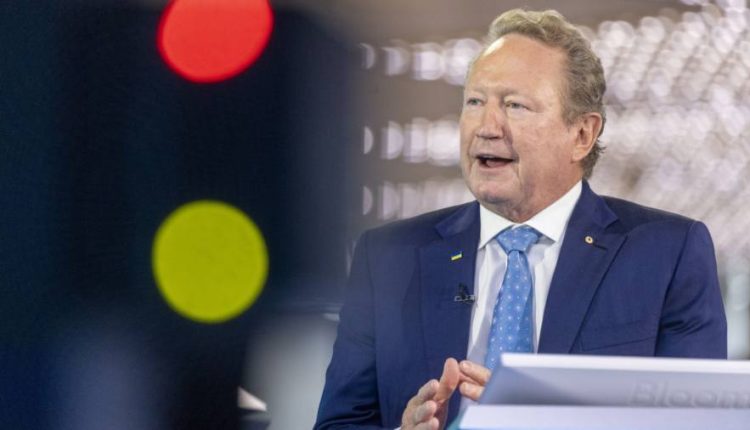Receive free Fortescue Metals Group Ltd updates
We’ll send you a myFT Daily Digest email rounding up the latest Fortescue Metals Group Ltd news every morning.
Andrew Forrest, billionaire founder and executive chair of Fortescue, Australia’s third-largest mining company, turned up at the group’s 20-year anniversary party on a mining truck, waving a company flag as AC/DC’s Thunderstruck blared out of speakers.
Celebrations carried on into the night as 700 guests, who were flown to the company’s Solomon mine in the West Australian desert on charter flights, were treated to a light show, an oyster bar and a concert by rock singer Jimmy Barnes.
Forrest, who had failed with a previous nickel venture, founded Fortescue in 2003 and built it into a A$62bn ($40bn) mining major able to compete against BHP and Rio Tinto. One of Australia’s biggest corporate success stories of the past two decades, Fortescue has transformed the former stockbroker into Australia’s richest man.
Yet the festivities masked divisions within the mining company, which operates both as an iron ore miner and a pioneer of green hydrogen investment.
Just days after the party, Fiona Hick, the chief executive of its metals division, left by mutual agreement after six months in the role.
Christine Morris, who Hick brought in as chief financial officer of the metals group, had been in place for only two months before she departed. Guy Debelle, who gave up his role as deputy governor of the Reserve Bank of Australia to join the green hydrogen division of Fortescue last year, also left the company last week.
Further exits at some of Forrest’s other businesses have added to the impression of an exodus.
What analysts have called a “revolving door” of executives raises questions about the culture — described by Forrest as a “boiler room” — at the company.
At internal meetings in the run-up to the party, held at Forrest’s farm Minderoo Station, top Fortescue executives laid bare differences in opinion over the speed and approach to decarbonising the company’s mining operations by 2030, according to two people with knowledge of the situation.
Mark Barnaba, deputy chair of Fortescue, told the Financial Times that the executive departures made sense for the company. “You don’t propose marriage after three or four dates but you can’t do that with a new CEO or CFO. It became very clear it wasn’t a good fit,” he said.
“The board felt that it was unequivocally stronger governance to admit that it wasn’t working and make a courageous decision to part ways rather than to retain the status quo simply because the short-term media may not be pleasant. This takes courage and a strong culture.”
The extraordinary set of departures nonetheless triggered concern among investors and shares remain 5 per cent lower than they were the day before Hick left.
Peel Hunt analysts said that “at best” the sudden departure of Hick, Morris and Debelle smacked of a “massive disagreement over the direction of the company”.
Large mining groups including BHP and Rio Tinto have announced bold plans to decarbonise their mining operations but none has gone as far as Fortescue.
Fortescue’s green strategy was launched three years ago and ranges from developing trains, ships and trucks that run on hydrogen to reducing the carbon emissions of its mines. It acquired the former battery arm of the Williams Formula 1 racing team last year.
It is also investing directly in the production of electrolysers — used to create the energy source from water — as well as international green hydrogen projects.
The success of that strategy is not yet evident. In the year to June 2023, Fortescue’s metals group generated $16.8bn of revenue and earnings before interest, taxation, depreciation and amortisation of $10.5bn. The energy division in contrast achieved revenue of $107mn and a loss of $617mn.
Forrest has also lobbied governments, including the UK’s, to adopt green hydrogen strategies as part of his decarbonisation crusade.
Two days after the departure of Hick, Forrest spoke at the Boao Forum for Asia in Perth about “lethal humidity”. That talk included slides arguing that the world had “Stockholm syndrome” due to its reliance on fossil fuels and on how the structures that support life on the planet were set to unravel. “Like an egg, they can’t be uncooked,” the slide deck declared.
Rachel Waterhouse, chief executive of the retail investor group Australian Shareholders Association, said that her members “really want stability” from companies such as Fortescue.
Dino Otranto, who was promoted to replace Hick at the helm of Fortescue Metals Group, and Mark Hutchison, chief executive of the energy division, met investors in Australia and is set to fly to London and New York in the coming days for further shareholder meetings.
Forrest, who flew to the Africa Climate Summit in Nairobi this week, told staff that the new management team was steeped in Fortescue’s culture. “I now believe we have a team of insiders, not outsiders, who will take us forward within our values,” he said in an internal email to staff seen by the FT.
Barnaba said that the company still retained the ethos that had created a mining success story.
“We are growing new businesses with a very firm eye on costs, rates of return and competitive advantage. None of that commercial focus has gone out the window,” he said, adding that the executive departures should not detract from its 20-year growth story. “It’s a storm in a teacup.”
Debelle said he left to work in the fast-growing critical minerals sector, joining Tivan, a small vanadium developer. Neither Hick nor Morris responded to requests for comment.
Read the full article here

